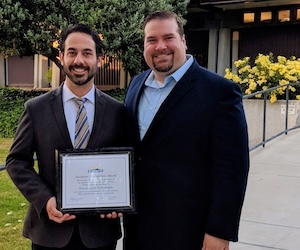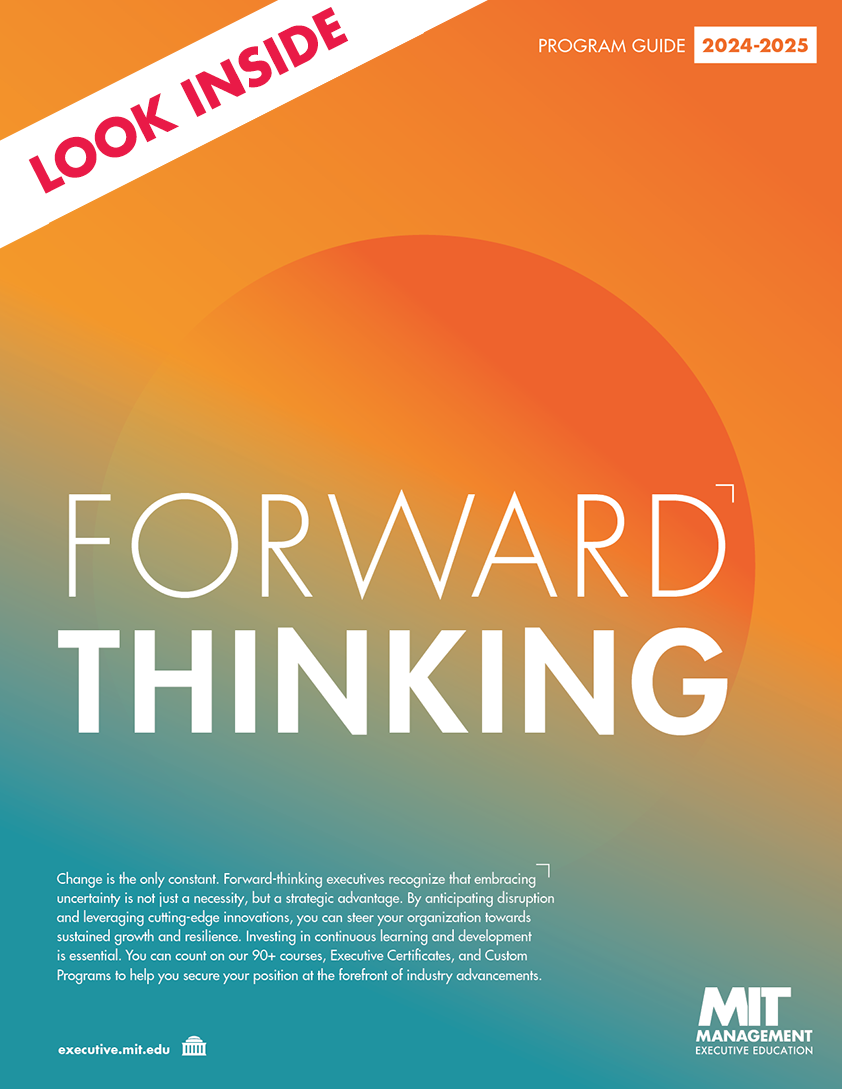When we asked Jonathon Feit to share his MIT experience with us, and to catch us up on everything that has happened since, he was naturally reflective. While so much has happened for Jonathon in recent weeks and months, he couldn’t help but think back to the early aughts and the decisions and experiences that brought him to this moment in time.
From co-founding the magazine Citizen Culture at just 23 years of age to becoming a pioneer in the shift to digital publishing to his stint as the youngest faculty member at Boston University’s College of Communication, Jonathon has always been an innovator, and entrepreneur, and someone determined to move his industry forward—whatever that industry may be. He has always had an uncanny ability to seize upon a truly disruptive idea. But perhaps most interesting about Feit is how he has been able to take kernels of ideas—even failed ideas—and ignite them into lifechanging solutions.
From magazines to movements
“Back when I was teaching a digital innovations course at BU, the capstone assignment for my class was to produce a prototype and, more importantly, a business plan for an innovative media product,” says Jonathon. “And even though this was 2006, 2007, I still remember a couple of them. One was a model of advertising comprising three-second ads. I remember saying, ‘there's no way that's going to fly.’ Of course, it turns out in Europe they do those all the time, as quick interstitial ads,” he laughs.
“The other one was a same sex wedding magazine, and I remember thinking, that's interesting. This was a time when that was still a very hot topic, and the team came up with a compelling presentation. When the course was over, I actually ended up prototyping a magazine with them called With This Ring. It turned out to be the first inclusive—same sex, interracial, and interfaith—wedding magazine.”
Jonathon described it as a publication that included style and fashion features, interviews, profiles, and content patterned on the kinds of articles one would see in magazines like Cosmo or Glamour. It was both familiar and entirely novel.
“I got a live, in-person interview with Gavin Newsom when he was the mayor of San Francisco. And so being able to talk to him about same-sex marriage when this was an actual question…I mean, it was compelling. But by the time the next presidential election cycle occurred, the whole idea of same-sex marriage seemed to be something America claimed it wasn’t ready for. We were early. Three or four years later, we would have been a roaring success,” says Jonathon. Then he laughed. “But it was great. A straight white single man publishing a magazine about literally everything else.”
Jonathon moved back to his hometown of Los Angeles, the magazine behind him and an uncertain political climate ahead. He had begun working with a partner to develop a website for event planners, and the idea hit him that same-sex weddings were a natural adjunct for this product.
“This was back when the controversy first erupted around wedding vendors who refused to serve same sex couples. I realized that even though the publication wouldn’t necessarily work, we could develop a tool that would help individuals find friendly vendors.” Jonathon explained how the tool evolved into an early model of affiliate marketing, where anyone could post an event and then find everything “from the venue to the clothes to the flowers to the cigars.” Jonathon’s business would collect a small fee as people and businesses transacted, like a small software-as-a-service venture.
“It was exciting, because a social movement was mounting, and we were going to be a positive part of that movement.” Jonathon was also excited because this was when he decided to enroll in MIT’s week-long Entrepreneurship Development Program, to acquire additional skill sets that would help propel their company.
Unfortunately, this was also the moment that his business partner, who was responsible for developing the code essential to powering the tool, disappeared—and took the code with him.
“I’m not a coder. I’m a business guy, a writer, a marketer,” Jonathon explains. “So, when that partnership ended abruptly, I was in no man’s land.”
A pivot into healthcare, inspired by EDP
When Jonathon walked onto the MIT campus, his wounds were still fresh. But early into the program, he had a transformational learning experience with Mike Grandinetti, an entrepreneur, innovation expert, and award-winning professor.
“Mike was teaching a session on product-market fit. He gave us a challenge. Take an idea that you’ve had as an entrepreneur and move it in a different direction. For example, ask yourself, if you were going to start your entire career over, what would you do? And could that idea you had somehow be applicable in that entirely new career?”
For Jonathon, part of that answer was easy. He always had a deep passion for the biomedical sciences. In fact, many of his studies in school involved neuropsychology or medicine. “I come from a family with a lot of doctors in it,” says Jonathon, “and the idea of going into the medical business was really compelling, but I was a journalist…”
“When I started working in journalism, I was looking at science journalism and really interested in areas like biopsychology and neuropsychology, maybe in part because I have Tourette's syndrome. Some of these topics appealed to me because I lived them. So, when Mike said, ‘start over,’ I asked myself, if I were to go into the biomedical field, into the business of science, what would I do?”
And that’s when it struck him.
Jonathon asked himself I he could take the same concept of putting all the pieces together for an event and instead use it to look at a healthcare experience. In particular, how could he help people with a physical disability or a disease, like diabetes? What do they need? What are all the pieces that need to be brought together?”
His mind began to race as he realized that the idea of assembling an ecosystem of information for events could laterally apply to viewing, in one place, a range of information that is relevant to caring for patients with serious, often chronic diseases and many caregivers who want to pull in the same direction but find it fiercely challenging to share information cohesively, securely, and quickly. In that moment, in that classroom, the idea of MEDIVIEW was born.
How a week can change an entire profession
Of course, Jonathon’s journey had more road to hoe. A year after EDP, after toiling with entrepreneurship, he decided to enroll in an MBA Program at Carnegie Mellon.
“You might remember 2008. That may have been the single worst time to be in business school,” he says with a laugh. The economy may have been falling apart around him, but serendipity led him to his next business partner, Chris Witt.

Jonathon with Cofounder Chris Witt
“Chris had worked at Boeing. He's a genius technologist. We got together with the idea that we would start a company. His father William, who had recently passed away in a car crash along with Chris’s sister Sarah, was a full-bird colonel in the U.S. Air Force. So, Chris had a strong orientation toward military applications for whatever we would create together—as did I, because I enlisted in the U.S. Army Reserve on September 11, 2001. The original plan was to become a field medic.”
Jonathon and his new partner compiled their knowledge and decided to focus on a device that would conduct rapid diagnosis and therapeutics on patients with post-traumatic stress disorder and traumatic brain injury—a need of particular significance for active military and veterans.
"I realized, everyone was here to start, or try to start, the next big thing. And it was the most electric, energetic, motivating feeling I've ever had in my entire career."

“And of course, it all comes back to MIT, where the number one thing everybody tells you is: Talk to your audience. Talk to your customer. Understand what their needs are. And so, we picked up the phone and we called the Army and we talked to medical commanders who said, ‘we love the idea of providing therapeutics to war fighters and the veterans who are suffering, but we don't know enough about the patients to administer those therapeutics.’ They wanted us to focus on the diagnostics.”
The pair dove headfirst into understanding how diagnostics are conducted in the field, how and where that data is collected, and how responders and doctors come to understand the mechanisms of the injuries and the patients’ social determinants of health. Next, they needed to figure out how all that critical information could be integrated and presented on a screen such that the responders in the field and the hospitals providing care had context. Jonathon, of course, had the perfect solution for that: MEDIVIEW.
Beyond Lucid Technologies has been going strong for fourteen years. Between 2013 and 2023, MEDIVIEW has been used by Fire and EMS agencies in 33 states and territories, with 300+ hospitals on their interoperability (patient information sharing) network. Their reach and applications continue to grow.
“In Oregon, for example, we implemented the country's first interoperable registry of children with special health needs, severe illness, and disability. The platform is called the MEDIVIEW BEACON Prehospital Health Information Exchange. And so, when I say that one week at MIT changed my life, I also mean it has changed and continues to change the lives of children and adults whose special health and end-of-life medical orders are now visible to the responders in the field, the 300 hospitals that are on the network, and the health information exchange across multiple states.”
Jonathon mentions that MIT factors into his business in more ways than one, noting that their Chief Engineer, David Saylor, is an MIT alumnus.

David Saylor Chief Engineer MIT '04, '05
He also cites an influential EDP lesson from Professor Ken Morse, Founding Managing Director of the MIT Entrepreneurship Center, who said that a CEO has one duty: to find, train, and retain ‘eagles’—the absolute best talent one can attract and ideally far smarter than the CEO doing the recruiting.
At the time we spoke with Jonathon, Massachusetts had just signed a contract with his company (Beyond Lucid Technologies, Inc.) to begin bringing EMS and fire data to all the hospitals on their statewide network.
“All of this links back to that one week in EDP. We can literally say this one program changed an entire profession.”
“We’re all here to start the next big thing”
Jonathon and his company continue to break new ground. Beyond Lucid Technologies was the first to put telemedicine in the back of an ambulance, the first to put speech-to-text in an ambulance, and the first to put social determinants tracking for longitudinal views of patient's health over time in an ambulance.
“No one had done this before. And it's all based this thing that I prototyped in EDP. Sometimes I ask myself, what would have happened if I had never enrolled? It’s serendipity. And it’s like that movie, ‘The Adjustment Bureau.’ MIT’s Entrepreneurship Development Program was like my Adjustment Bureau. And you can quote me on that!”
Jonathon also laughs thinking about how none of this might have happened if the code for his event planning tool hadn’t been stolen. “And now we’re literally connecting healthcare ecosystems across the United States and beyond. You can't pray for that, let alone plan it. So, it's a pretty remarkable set of confluences.”
Earlier this month, the Central Shenandoah EMS (CSEMS) Region of Virginia announced the deployment of KIDS OF VALR (Virginia Life Registry), a local program of the R.U.S.H. (Rare & Under-Served Health) Initiative for Children. Beyond Lucid Technologies launched the R.U.S.H. Initiative for Children to close critical gaps in care by pairing data systems with both emergency and non-emergency clinical partners, in service of vulnerable young people with serious illnesses and disabilities.
The program, which is sponsored in part by Amazon Web Services’ Health Equity Initiative, brings together a range of clinical partners and tech-enabled services—including Jonathon’s company—to share information in real-time, when a young person is in healthcare distress.
“There is making money, and then there is making an impact. It’s an important thing to be able to make money; obviously, you don't go to someplace like MIT Sloan to not make money. But, to make an impact, especially at a scale where you can solve for parents having to tell responders over and over again about their kids’ needs—that’s another thing entirely. Then to have Amazon say, ‘we believe in what you're doing and here's money to support it,’ well, it’s truly remarkable.”
Jonathon admits that he wasn’t the only EDP participant more interested in disruption than incremental change. “I think this defines the EDP participant. I remember sitting in one of the big assembly rooms at MIT surrounded by global entrepreneurs, people from firms like Accenture and Deloitte and Bosch, and then there was me, an independent magazine publisher. And I realized, everyone was here to start, or try to start, the next big thing. And it was the most electric, energetic, motivating feeling I've ever had in my entire career.”
If you are ready to change your industry and potentially the world, we invite you to learn more about the Entrepreneurship Development Program.
You can learn more about the MEDIVIEW Platform and Beyond Lucid Technologies here.








